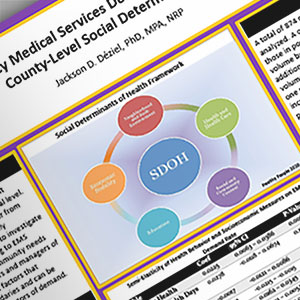ABSTRACTS
Emergency Medical Services Demand: An Analysis of County-Level Social DeterminantsAuthor: Jackson Deziel PhD, MPA, NRP | Director | Western Carolina University Associate Authors: Deziel, Jackson, D, PhD, MPA, NRP | Raming, Brian, PhD, MBA, NRP
Introduction EMS demand is ever-present, but significant variations exist when observed at the local level. In this paper’s dataset, annual county-level consumption of EMS varied greatly, from 153 to 11,248 calls per 10,000 persons. Therefore, it can be assumed that the market for ambulance services is far from homogeneous. This unclear, and largely unspecified, heterogeneity leads us to investigate potential social factors contributing to EMS demand. Although individual community needs are of great import for designers and managers of EMS systems, there may exist factors that transcend geopolitical boundaries and can be bookmarked as universal predictors of demand. Methods Data for this study were collected from publicly available reports from Florida and Oklahoma. Each state reported total annual requests for service per county from 2009 through 2015. County-level health and social data were gathered by the Robert Wood Johnson Foundation (RWJF). For analysis, call volume (per 10,000 persons) was log-transformed to derive a semi-elasticity function. Pooled ordinary least squares model with time-fixed effects were utilized for tests of inference. Results A total of 874 county-year observations were analyzed. A one percentage-point increase in those in poor or fair health increased EMS call volume by 3% (B=0.03, p<0.000). For each additional day of poor mental health, EMS call volume increased by 6.5% (B=0.065, p=0.001). A one percentage-point increase in binge drinking increased EMS call volume by 1.6% (B=0.016, p<0.000). A one percentage-point increase in uninsured adults decreased EMS call volume by 1.1% (B=0.011, p=0.004). A one percentage-point increase in the unemployment rate increased EMS call volume by 3.6% (B=0.036, p<0.000). A one percentage-point increase in child poverty increased EMS call volume by 0.6% (B=0.0059, p=0.036). An increase in the violent crime rate increased EMS call volume by (B=0.00028, p<0.000). Conclusion After examination, the data support the notion that some community measures and behaviors have a significant effect on local EMS demand. These factors may have been treated as spurious or completely overlooked by policy makers and EMS leadership.
|

